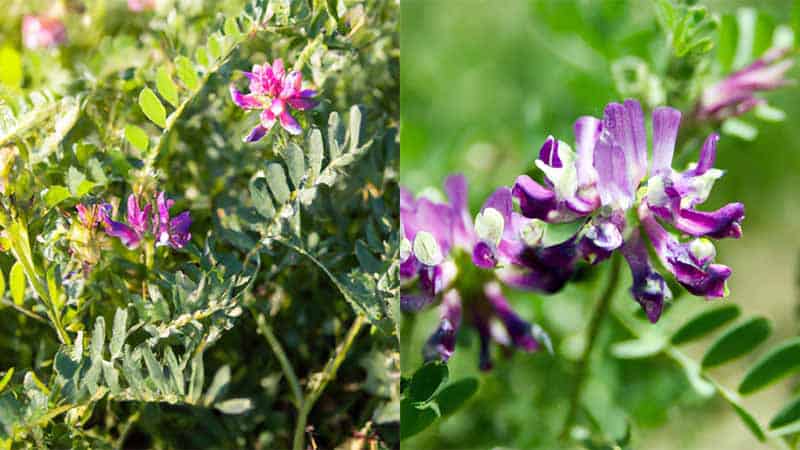Chinese Milk Vetch (Astragalus sinicus) is a remarkable legume that holds immense potential for both agricultural and gardening endeavors. With its ability to fix nitrogen and improve soil fertility, this versatile plant offers numerous benefits to those who cultivate it. Whether you’re a farmer looking to enhance the health of your fields, a gardener seeking an eco-friendly alternative to synthetic fertilizers, or an enthusiast eager to explore new plant species, understanding the art of growing Chinese Milk Vetch is essential. In this comprehensive guide, we will delve into the intricacies of cultivating Chinese Milk Vetch, exploring the optimal techniques and practices that will lead to a bountiful harvest. So, grab your gardening tools and get ready to unlock the secrets of successful Chinese Milk Vetch cultivation for a sustainable and fruitful future.

Understanding Chinese Milk Vetch
Chinese Milk Vetch, scientifically known as Astragalus sinicus, is a leguminous plant native to East Asia, particularly China and Japan. This hardy perennial herb from the Fabaceae family is well-known for its symbiotic relationship with nitrogen-fixing bacteria in its root nodules, which allows it to fix atmospheric nitrogen. By increasing soil nitrogen levels, decreasing the need for synthetic fertilizers, and increasing soil fertility, Chinese Milk Vetch is an essential component of environmentally responsible farming.
Varieties and Selection
Chinese Milk Vetch offers a range of varieties, each with unique characteristics and adaptability to different climates and soil types. Some popular cultivars include ‘Hokkai-Tokusen,’ ‘Okayama,’ and ‘Fukuyutaka.’ When selecting a variety, it’s important to consider factors such as regional climate, soil conditions, and intended use. Certain varieties may be better suited for cover cropping or as forage, while others may excel in green manure production or erosion control. By choosing the appropriate variety, you can maximize the benefits and yield of your Chinese Milk Vetch cultivation.
Ecological Benefits
One of the primary reasons for cultivating Chinese Milk Vetch is its remarkable ecological benefits. This remarkable legume has the ability to convert the nitrogen in the air into a form that can be utilized by other plants, thereby increasing soil fertility and promoting healthier crop growth. The nitrogen-fixing process not only reduces the reliance on synthetic fertilizers but also helps in minimizing environmental pollution caused by nutrient runoff. Furthermore, Chinese Milk Vetch exhibits excellent tolerance to drought, making it a resilient and sustainable choice for agricultural practices.
Agricultural Applications
Chinese Milk Vetch finds wide applications in agriculture, offering numerous advantages to farmers and gardeners. As a cover crop, it helps suppress weeds, prevent soil erosion, and improve soil structure. Its dense foliage acts as a natural mulch, conserving moisture and providing a protective layer to the soil. When incorporated into crop rotation, Chinese Milk Vetch can break pest and disease cycles while replenishing soil nutrients. Additionally, the plant’s high protein content makes it a valuable source of forage for livestock, contributing to the overall sustainability of farming systems.
By familiarizing yourself with the characteristics, varieties, and ecological benefits of Chinese Milk Vetch, you lay a solid foundation for successful cultivation. In the following sections, we will explore the essential steps involved in preparing the soil, planting, and caring for Chinese Milk Vetch, enabling you to harness its full potential in your gardening or farming endeavors.
Soil Requirements
Before diving into planting Chinese Milk Vetch, it is essential to understand the soil requirements that contribute to optimal growth and development of the plant. Chinese Milk Vetch thrives in well-draining soils with a pH range of 6.0 to 7.5. The soil should ideally be loamy or sandy, allowing proper aeration and root penetration. Conducting a soil test to determine the nutrient levels and pH of the soil is highly recommended. This information will help you make necessary amendments to create an ideal growing environment for Chinese Milk Vetch.
Soil Preparation
Proper soil preparation is vital to ensure favorable conditions for Chinese Milk Vetch to establish and thrive. Follow these steps to prepare the soil effectively:
- Clear the area: Remove any existing vegetation, weeds, and debris from the planting site. This eliminates competition and provides a clean slate for your Chinese Milk Vetch to grow.
- Loosen the soil: Use a garden tiller or a shovel to loosen the top layer of soil. Breaking up compacted soil allows for better root penetration and nutrient absorption. Aim for a depth of 6 to 8 inches for optimal results.
- Incorporate organic matter: Add organic matter, such as well-rotted compost or aged manure, to enrich the soil. This improves soil structure, enhances water retention, and provides essential nutrients for the Chinese Milk Vetch plants.
- Address soil deficiencies: Based on the results of the soil test, address any nutrient deficiencies or pH imbalances by adding appropriate amendments. For example, if the soil lacks nitrogen, consider adding a nitrogen-rich fertilizer or utilizing the nitrogen-fixing properties of Chinese Milk Vetch itself.
- Smooth and level the soil: Rake the soil surface to remove large clumps and create a smooth, level surface for planting. This allows for uniform seed distribution and consistent growth of Chinese Milk Vetch plants.
By adequately preparing the soil, you provide the foundation for healthy root development, nutrient uptake, and overall growth of Chinese Milk Vetch. In the next section, we will delve into the specific techniques for planting and caring for Chinese Milk Vetch to ensure a successful and productive cultivation journey.
Planting Time and Location
Understanding the ideal planting time and suitable location for Chinese Milk Vetch is crucial for its successful growth. Depending on the local climate, Chinese Milk Vetch is usually planted in the early spring or late summer. It thrives in areas with moderate temperatures and prefers full sun to partial shade. Choose a location that offers well-drained soil and adequate sunlight to promote vigorous growth and optimal nitrogen fixation.
Planting Techniques
Follow these planting techniques to ensure proper establishment of Chinese Milk Vetch:
- Seed preparation: If using seeds, soak them in water overnight to enhance germination rates. This softens the seed coat and promotes faster and more consistent germination.
- Seed spacing and depth: In rows, plant the seeds about an inch deep (2.5 cm) or broadcast them over the prepared soil. Space the seeds around 2 to 3 inches (5 to 7.5 cm) apart, allowing room for the plants to spread and develop.
- Seedling transplantation: Alternatively, you can start Chinese Milk Vetch seeds indoors in seed trays or pots and later transplant the seedlings into the garden. Ensure that the seedlings have developed a strong root system before transplanting them outdoors.
- Watering: After planting, water the soil gently but thoroughly to provide adequate moisture for seed germination or seedling establishment. Maintain moist soil during the early growth stages, but avoid overwatering, as excessive moisture can lead to root rot.
Care and Maintenance
To ensure healthy growth and maximum nitrogen fixation, Chinese Milk Vetch requires regular care and maintenance. Consider the following practices:
- Weed control: Monitor the planting area and promptly remove any weeds that may compete with Chinese Milk Vetch for nutrients, water, and sunlight. Frequent weeding during the initial growth stages is essential to minimize weed interference.
- Watering: Chinese Milk Vetch has moderate water needs. Water the plants when the soil surface feels dry, aiming for a consistent level of moisture without waterlogging. Proper irrigation practices promote robust growth and help maintain optimum nitrogen-fixing activity.
- Fertilization: Chinese Milk Vetch is known for its nitrogen-fixing ability, reducing the need for additional fertilization. However, if the plants show signs of nutrient deficiency, such as yellowing leaves, you can supplement with a balanced organic fertilizer.
- Mulching: To prevent water loss, weed development, and temperature extremes at the plant’s roots, mulch the base of your Chinese Milk Vetch plants with an organic material. Mulching also contributes to overall soil health by improving its organic content as the mulch breaks down.
- Monitoring pests and diseases: While Chinese Milk Vetch is generally resilient, it can be susceptible to pests like aphids or diseases such as powdery mildew. Inspect the plants for pests and diseases on a regular basis and take appropriate measures, such as applying organic pest control methods or adjusting environmental conditions.
By implementing these planting techniques and practicing diligent care and maintenance, you can ensure vigorous growth, optimal nitrogen fixation, and a flourishing Chinese Milk Vetch crop. In the next section, we will explore the process of harvesting Chinese Milk Vetch and its versatile utilization in various applications.
Harvesting Chinese Milk Vetch
Knowing when and how to harvest Chinese Milk Vetch is crucial to maximize its benefits and utilization. Consider the following guidelines:
- Flowering stage: Chinese Milk Vetch typically reaches its peak harvest time when it is in full bloom. Look for vibrant and abundant flowers as an indication of readiness for harvesting.
- Seed development: If you plan to collect seeds for future planting, allow the pods to fully mature and dry on the plant. Harvest the pods when they turn brown and begin to crack open, revealing the seeds inside.
- Cut and collect: Use pruning shears or sharp scissors to cut the Chinese Milk Vetch plants at the base, just above the soil level. Collect the harvested plants in bundles or place them in a container for further processing or utilization.
Utilization and Crop Rotation
Chinese Milk Vetch offers a range of uses and benefits in various applications:
- Forage and fodder: Chinese Milk Vetch serves as an excellent source of high-protein forage for livestock, including cattle, sheep, and goats. Harvested plants can be dried, baled, or directly grazed upon, providing valuable nutrition for animals.
- Green manure and cover crop: Utilize Chinese Milk Vetch as a green manure or cover crop to improve soil fertility and structure. Before the plant reaches maturity, plow or till it into the soil, allowing the organic matter to decompose and release valuable nutrients for subsequent crops.
- Soil erosion control: Due to its extensive root system, Chinese Milk Vetch helps prevent soil erosion by stabilizing the soil and reducing water runoff. Planting Chinese Milk Vetch on slopes or areas prone to erosion can effectively protect the soil from being washed away.
- Crop rotation benefits: Integrate Chinese Milk Vetch into crop rotation plans to break pest and disease cycles. The nitrogen fixation properties of Chinese Milk Vetch enhance soil fertility, providing a favorable environment for subsequent crops to thrive.
- Seed saving: Mature pods containing seeds should be stored in a cool, dry place until they are needed for planting. Properly stored seeds can be used to propagate Chinese Milk Vetch in subsequent years.
By utilizing Chinese Milk Vetch in these various ways, you can enhance the sustainability and productivity of your agricultural practices while reaping the benefits of this versatile legume.
Conclusion
Chinese Milk Vetch (Astragalus sinicus) is a valuable plant that offers numerous benefits for sustainable agriculture and gardening practices. With its ability to fix nitrogen, enhance soil fertility, and serve as a versatile crop, Chinese Milk Vetch has the potential to revolutionize the way we approach cultivation. By understanding the proper techniques for preparing the soil, planting, and caring for Chinese Milk Vetch, Its full potential can be unlocked, allowing you to reap a plentiful harvest. Whether you utilize it as forage, green manure, cover crop, or in crop rotation, Chinese Milk Vetch contributes to healthier soils, reduced reliance on synthetic fertilizers, and increased productivity. Embrace the power of Chinese Milk Vetch and embark on a journey towards sustainable agriculture and greener practices for a better tomorrow.
